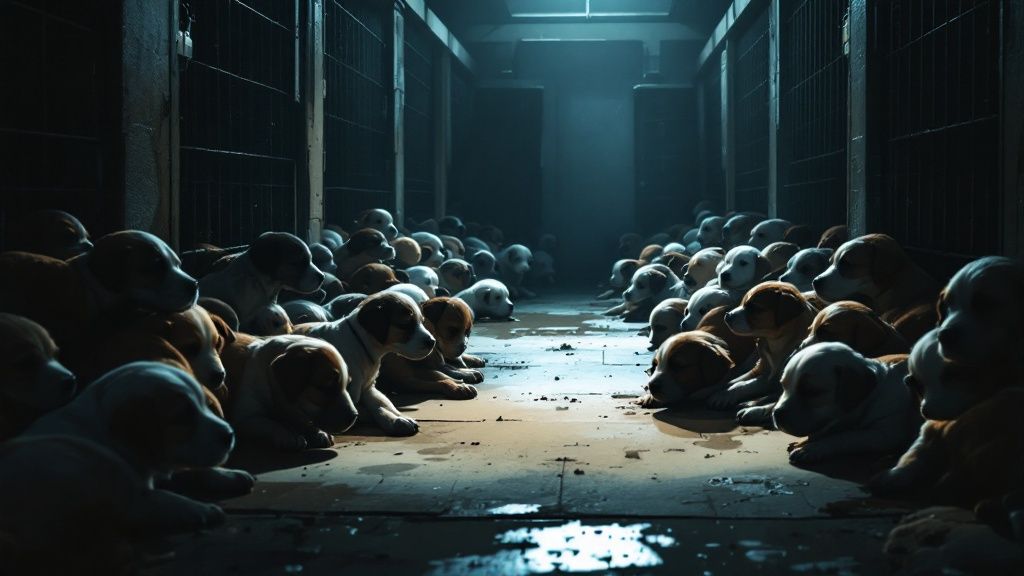Definition of Puppy Mills: A Complete Guide
- f85661678
- Apr 8
- 12 min read
The Real Definition of Puppy Mills: Beyond the Basics

The term "puppy mill" often brings to mind images of overcrowded cages and neglected animals. However, the reality is far more complex. A true understanding of puppy mills goes beyond these initial impressions and delves into a system that prioritizes profit over the well-being of dogs. This section explores the core characteristics that define a puppy mill and distinguishes these operations from responsible breeders.
Understanding the Core Issues
A puppy mill is a commercial dog breeding facility that focuses on producing a high volume of puppies, often disregarding the quality of care provided to the animals. These facilities can house hundreds of breeding dogs in deplorable conditions. This emphasis on quantity leads to a number of serious problems.
Individual animal care is often minimal. Basic needs like proper nutrition, regular veterinary care, and socialization are frequently neglected. This creates a cycle of suffering for the parent dogs, confined to cramped and unsanitary conditions for their entire breeding lives.
The puppies born in these environments often suffer from health and behavioral problems. This means the suffering continues long after the puppies leave the mill, impacting the families who purchase them. The continued demand for puppies, unfortunately, fuels this inhumane industry.
Public awareness about the realities of puppy mills and the importance of responsible pet acquisition is critical. Puppy mills are notorious for their substandard living conditions and lack of animal care. It is estimated that 4.3 million puppies are born in these facilities each year. Sadly, only about half survive their first 12 weeks. Approximately 70% of puppy mills operate illegally, making regulation and enforcement difficult. You can find more detailed statistics at Spots.com.
The Breeding Cycle and Its Consequences
The constant breeding cycles in puppy mills take a devastating toll on the dogs. Female dogs are bred at every opportunity, with little to no time to recover between litters. This relentless breeding weakens their immune systems, increasing the risk of health complications and shortening their lifespans.
The puppies are often removed from their mothers much too early. This premature separation hinders their social development and can lead to long-term behavioral issues. The lack of early socialization and proper care contributes to the many challenges faced by families who unknowingly adopt these puppies.
Recognizing Puppy Mill Practices
Regardless of how they present themselves, puppy mills often exhibit similar characteristics. A lack of transparency about the breeding environment is a key indicator. They may refuse to allow potential buyers to see the facilities where the puppies are raised. They might also have a large number of puppies available from various breeds. Recognizing these red flags is crucial for making informed decisions and avoiding supporting this harmful industry.
By understanding the true definition of puppy mills, we can begin to tackle this complex problem and strive for a future where all dogs receive the respect and care they deserve.
The Evolution of Puppy Mills: From Farms to Industry
The image of a puppy mill as a dingy, overcrowded facility is sadly often true. But how did these operations become so widespread? This exploration traces the disturbing shift in dog breeding from smaller farms to the large-scale, industrialized puppy production we see today. We'll examine the historical and economic factors that contributed to the rise of puppy mills and why they continue to exist.
Post-War Roots and the Rise of Commercial Breeding
The origin of puppy mills can be traced back to the post-World War II era. Midwestern farmers, struggling financially due to crop failures, sought new income sources. A burgeoning middle class and increasing suburbanization fueled a growing demand for companion animals, especially puppies. This combination of factors created the perfect environment for commercial puppy breeding to take hold. Learn more about the origins of puppy mills here.
This move towards commercial breeding marked a significant change in how dogs were raised. While some farmers may have begun with good intentions, the pressure to satisfy the increasing demand soon led to prioritizing profits over animal welfare. This marked the beginning of the industrialized approach to puppy production.
The Normalization of Mass-Breeding
As the demand for puppies continued to grow, the emphasis on quantity intensified. Larger facilities were built, housing hundreds of breeding dogs. These high-volume breeding operations became the standard, further solidifying the puppy mill model. This industrialization of dog breeding normalized practices that compromised animal care for economic efficiency.
Economic Challenges to Reform
The deeply ingrained economic structure of the puppy mill industry presents substantial obstacles to reform. Many of these operations function on a volume-based profit model, meaning their profitability depends on producing many puppies at the lowest possible cost. This often translates to minimal spending on animal care, veterinary services, and suitable living conditions.
Breaking this cycle requires addressing the underlying economic incentives that perpetuate these inhumane practices. Consumer education and a demand for ethically sourced puppies are essential for driving change within the industry. This highlights the need for increased public awareness about the definition of puppy mills and the importance of supporting responsible breeding.
Navigating the Regulatory Maze: Why Enforcement Falls Short

Public awareness of the inhumane conditions in puppy mills is growing. Yet, these operations continue. Why aren't these facilities being shut down? The answer is a complex and often insufficient regulatory system that allows substandard breeders to flourish. This section explores the legal complexities surrounding puppy mills and explains the frequent failures in enforcement.
The Animal Welfare Act: A Critical Look at Its Limitations
The Animal Welfare Act (AWA), established in 1966, sets minimum standards of care for animals bred commercially. However, these standards are often criticized as being inadequate. The AWA leaves significant loopholes that permit substandard living conditions.
For instance, specified cage sizes are barely large enough for a dog to turn around. There are no stipulations for exercise, socialization, or veterinary care beyond the most basic necessities.
This means a facility can technically comply with AWA standards while still subjecting dogs to cramped, unsanitary environments and minimal human interaction. This gap between legal compliance and acceptable animal welfare is a major obstacle to effectively regulating puppy mills. Regulation and oversight remain challenging due to a lack of transparency and inconsistent enforcement. The U.S. Department of Agriculture (USDA) is tasked with inspecting licensed facilities. However, only about 3,690 USDA Class A and B licensed facilities are expected to adhere to these basic standards. For more detailed statistics, visit Total Vet.
State Regulations: A Patchwork of Protections
State regulations further complicate the issue. Some states have implemented stricter laws than the AWA, affording stronger protections for breeding dogs. Other states, however, offer minimal oversight, leaving enforcement to the under-resourced USDA.
This inconsistent patchwork of regulations creates an uneven playing field. Puppy mills can simply move to states with lax laws to avoid stricter scrutiny. Even in states with more stringent regulations, enforcement presents difficulties.
Understaffed agencies often lack the capacity to perform regular inspections. This allows violations to persist undetected and unaddressed. The need for greater resources and more consistent enforcement of existing laws is critical.
To illustrate the variations in state-level regulations, let's examine the following table:
Puppy Mill Regulation Across States This table compares the different regulatory approaches to puppy mills across several U.S. states, highlighting the inconsistencies in legislation and enforcement that contribute to the persistence of these operations.
State | Commercial Breeder Laws | Minimum Standards | Enforcement Mechanism | Retail Sale Restrictions |
|---|---|---|---|---|
Pennsylvania | Requires licensing for kennels selling more than 60 dogs per year. | Sets standards for cage size, ventilation, veterinary care. | State Department of Agriculture | Some local ordinances restrict pet store sales. |
Virginia | Requires licensing for breeders selling to pet stores or more than four litters per year. | Specifies requirements for housing, sanitation, and record-keeping. | State Department of Agriculture and Animal Control | No statewide retail ban. |
California | Requires licensing for all commercial breeders. | Establishes standards for exercise, socialization, and veterinary care. | Local animal control and Department of Fish and Wildlife | Statewide ban on pet store sales of dogs, cats, and rabbits. |
This table highlights the significant differences in how states regulate puppy mills. While some states like California have implemented robust regulations, including retail sale bans, others have minimal standards and enforcement mechanisms. This lack of uniformity allows unscrupulous breeders to exploit loopholes and move to states with weaker protections.
The Power of Consumer Awareness: Driving Change From the Ground Up
Given the shortcomings of the regulatory system, consumer awareness is a vital tool in the fight against puppy mills. By understanding what constitutes a puppy mill and recognizing the signs of irresponsible breeding, consumers can make informed purchasing decisions.
Supporting legislation that strengthens animal welfare standards and restricts the sale of puppies in pet stores can significantly impact the puppy mill industry. These retail pet sale bans effectively disrupt a primary distribution channel for puppy mills. This encourages consumers to seek more ethical sources, such as reputable breeders and rescue organizations.
While the regulatory landscape is complex, informed consumers can be a powerful force for positive change. They can actively promote responsible breeding and improve the lives of countless dogs.
The Hidden Cost: Health Impacts Beyond the Purchase Price
Buying a puppy from a puppy mill carries significant consequences that extend far beyond the initial purchase price. Dogs from these facilities often endure a lifetime of health and behavioral issues due to the deplorable conditions they are raised in. This section delves into the devastating physical and psychological toll puppy mills take on these animals, drawing on veterinary research and data from animal rescue organizations.
Congenital Conditions: A Legacy of Improper Breeding
Puppy mills prioritize profits over responsible breeding. This results in frequent inbreeding and breeding of dogs with pre-existing genetic health problems. Consequently, puppies from these facilities frequently suffer from congenital conditions such as hip dysplasia, heart defects, and eye problems. These hereditary conditions can necessitate expensive, ongoing veterinary care, negatively affecting both the dog’s quality of life and the owner’s finances.
For instance, hip dysplasia, a common ailment in puppy mill dogs, causes debilitating pain and restricted mobility. This condition may require surgery and long-term pain management.
Preventable Diseases: The Dangers of Unsanitary Environments
The cramped, unsanitary environments typical of puppy mills are ideal breeding grounds for contagious diseases. Diseases like parvovirus, distemper, and kennel cough spread rapidly in these overcrowded conditions. Puppies from mills are therefore at a heightened risk of contracting these often serious, and occasionally fatal, illnesses. Furthermore, the lack of proper veterinary care in these facilities allows diseases to go untreated, exacerbating the health risks for the dogs and increasing the potential for transmission to other animals.
Long-Term Behavioral Challenges: The Impact of Early Deprivation
A puppy’s early life is critical for social development. However, in puppy mills, puppies are often deprived of proper socialization with both humans and other dogs. They are frequently confined to small cages with minimal human interaction. This early deprivation can lead to significant behavioral issues, including fear, anxiety, aggression, and difficulty bonding with their adoptive families.
This means dogs rescued from puppy mills often struggle to adapt to a normal home environment. They may exhibit destructive behaviors, have difficulty with house-training, and struggle to form healthy attachments.
Rehabilitating these dogs often requires specialized training and considerable patience from their adoptive owners. While many dogs from puppy mills can eventually flourish in loving homes, the lingering effects of their early trauma can present a lifelong challenge. Understanding the nature of puppy mills enables potential pet owners to make informed choices and avoid contributing to the suffering of these animals. Resources like the U.S. Animal Abuse Registry can help potential pet owners research and identify individuals convicted of animal cruelty.
Following the Paper Trail: How Puppy Mills Reach Consumers

Puppy mill puppies often appear in seemingly reputable places. This begs the question: how do puppies from these problematic breeding facilities end up with unsuspecting consumers? This section explores the intricate distribution networks designed to mask a puppy's true origins. We'll follow the journey from breeding facility to consumer, shedding light on how this system works.
The Role of Brokers: Middlemen in the Puppy Trade
Brokers act as intermediaries between puppy mills and pet stores. They buy puppies in bulk from mills and sell them to retailers, often concealing the animals' source. This makes it difficult for consumers to trace a puppy back to a mill.
This lack of transparency is a major factor in the puppy mill industry's persistence. A pet store might claim their puppies come from "local breeders" when, in reality, they come from a mill hundreds of miles away via a broker.
Transportation Challenges: Further Compromising Puppy Health
Transporting puppies over long distances introduces added stress and risk. Puppies are often packed into cramped, poorly ventilated crates and transported for hours or even days.
This can worsen existing health problems and spread diseases. Young puppies are especially vulnerable to the stress of transport, which weakens their immune systems and makes them more susceptible to illness.
Deceptive Marketing Tactics: Misleading Well-Intentioned Buyers
Puppy mills and the businesses that sell their puppies frequently use deceptive marketing tactics. Appealing websites and social media pages project a wholesome image, hiding the harsh realities of their breeding practices.
They may use terms like "family-raised" or "home-bred" to create a false sense of security. Often, they avoid giving detailed information about the parents or the breeding environment. These tactics mislead buyers who are excited to bring a new puppy home.
To help illustrate the key differences between puppy mills and responsible breeders, the table below offers valuable insights for prospective puppy owners.
Identifying Puppy Mill vs. Responsible Breeder Practices: This table highlights the key differences between puppy mills and responsible breeders to help consumers make ethical choices when considering a puppy purchase.
Criteria | Puppy Mill Practices | Responsible Breeder Practices | How to Verify |
|---|---|---|---|
Transparency | Limited or no access to breeding facilities | Open and welcoming to visits | Ask to see the breeding environment |
Number of Breeds | Often multiple breeds available | Typically specialize in one or two breeds | Check their website or social media |
Puppy Availability | Puppies readily available year-round | Litters are planned and spaced out | Inquire about waiting lists |
Health Testing | Minimal or no health testing | Comprehensive health screenings for parent dogs | Ask for documentation of health tests |
Focus | Profit-driven | Focused on animal welfare and breed improvement | Observe their interaction with the dogs |
Living Conditions | Overcrowded and unsanitary conditions | Clean and spacious living areas for dogs | Visit the facility in person |
This table summarizes the key differences that prospective puppy buyers should consider. Recognizing these differences can help avoid supporting unethical breeding practices.
Identifying the Red Flags: Spotting Puppy Mill Practices
Several warning signs can suggest a puppy might come from a mill. Online listings with numerous breeds available or unusually low prices can be red flags. Pet stores that refuse to disclose their breeders or let potential buyers see where the puppies are raised should also trigger concern.
Also, be wary of sellers who dodge specific questions about a puppy's parents or health history. The U.S. Animal Abuse Registry is a helpful resource for identifying individuals and businesses with a history of animal abuse. Knowing these red flags empowers consumers to make informed decisions and avoid supporting the puppy mill industry.
The Economics of Puppy Mills: Profit Over Welfare
The puppy mill industry's business model prioritizes profit over animal welfare. Low operating costs due to neglecting basic animal care, combined with high puppy demand, allows these facilities to generate substantial profits. This economic incentive drives their unethical practices and hinders efforts to dismantle the system.
Consumer education and responsible pet acquisition are crucial for driving change.
Finding Your Ethical Puppy: Practical Steps That Make A Difference

Bringing a new puppy into your home is a joyous occasion. But it's crucial to ensure your new furry friend comes from an ethical source. This section provides practical steps to help you find an ethically sourced puppy, supporting responsible pet ownership and animal welfare. When considering ethical options, the source of the puppy is paramount, as discussed in this helpful guide on adopting or buying a teacup puppy.
Identifying Responsible Breeders: Key Questions And Considerations
Finding a responsible breeder requires diligent research and careful consideration. These breeders prioritize the health and well-being of their dogs over profit. Begin your search by asking direct questions about their breeding practices.
How many breeds do they work with? Responsible breeders typically specialize in one or two breeds. This allows them to dedicate their attention to breed-specific health and temperament considerations.
Can you visit their facility? A reputable breeder will welcome visits to their facility. This transparency provides firsthand insight into where the puppies are raised and demonstrates pride in their operation.
What health tests are conducted on the parent dogs? It's essential to request documentation of health screenings performed on the parent dogs to ensure they are free of breed-specific health issues.
What is their breeding history? Experienced breeders often have established reputations and extensive knowledge of their chosen breeds.
Open communication is a vital sign of a responsible breeding program.
Verifying Ethical Practices: On-Site Visits And Documentation
Don't hesitate to request references from past puppy buyers. Talking to other families who have adopted from the breeder can offer valuable perspectives on their experiences. Also, reach out to local breed-specific rescue organizations. These groups often have extensive networks and can suggest ethical breeders in your area. When you visit a breeder, pay close attention to how they interact with their dogs. Do they demonstrate genuine care and affection? A responsible breeder will prioritize the long-term welfare of their dogs, not just producing puppies for sale.
Exploring Alternatives: Breed-Specific Rescues And Shelters
If you're open to different breeds, adopting from a shelter or rescue organization can be an incredibly rewarding experience. Shelters are filled with loving dogs of all ages, shapes, and sizes hoping for a second chance.
Breed-specific rescues focus on rehoming particular breeds. This is an excellent option if you have a breed preference but still want to adopt. Adoption counselors can help you navigate the process and find a dog that complements your lifestyle and family.
Leveraging Resources: Online Databases And Adoption Events
Many online databases and resources connect prospective adopters with dogs in need. Websites like Petfinder and Adopt-a-Pet let you search for adoptable dogs in your area based on breed, age, and size. Attending local adoption events provides a great opportunity to meet potential pets and learn about different breeds and adoption procedures.
By following these proactive steps, you can find the perfect canine companion while supporting ethical breeding practices. Choosing a responsible breeder or adopting a rescue dog ensures your new family member begins life on the right paw and helps create a better world for all dogs.
Reporting Suspected Puppy Mills: Taking Action For Animal Welfare
If you encounter a situation that raises concerns about a breeder's practices, report it. Contact your local animal control agency or the Humane Society of the United States to file a report. Organizations like the U.S. Animal Abuse Registry ([https://www.usaar.org](https://www.usaar.org)) offer invaluable assistance in reporting suspected animal cruelty and holding offenders accountable. By working together, we can ensure all dogs are treated with the respect and care they deserve.
Comments